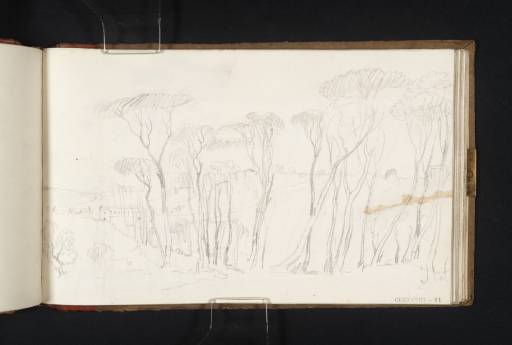Joseph Mallord William Turner Grounds of the Villa Borghese, Rome, Looking towards the Villa Guilia 1819
Joseph Mallord William Turner,
Grounds of the Villa Borghese, Rome, Looking towards the Villa Guilia
1819
Joseph Mallord William Turner 1775–1851
Folio 62 Recto:
Grounds of the Villa Borghese, Rome, Looking towards the Villa Guilia 1819
D16267
Turner Bequest CLXXXVIII 61
Turner Bequest CLXXXVIII 61
Pencil on white wove paper, 114 x 189 mm
Stamped in black ‘CLXXXVIII 61’ bottom right
Accepted by the nation as part of the Turner Bequest 1856
References
1909
A.J. Finberg, A Complete Inventory of the Drawings of the Turner Bequest, London 1909, vol.I, p.560, as ‘Row of trees, with hill beyond (probably gardens of Villa Medici).
1984
Cecilia Powell, ‘Turner on Classic Ground: His Visits to Central and Southern Italy and Related Paintings and Drawings’, unpublished Ph.D thesis, Courtauld Institute of Art, University of London 1984, p.426, as ‘62a includes the note Doria Pmp, so 61–3 probably all show views in the grounds of Villa Doria Pamphili’.
1969
John Gage, Colour in Turner: Poetry and Truth, London 1969, p.101 note 127.
Owing to the inscription in the top right-hand corner of folio 63 verso (D16269; Turner Bequest CLXXXVIII 62a), Cecilia Powell made the logical assumption that the sketches on folios 62–64 (D16267–D16270; Turner Bequest CLXXXVIII 61–63), depict the grounds of the Villa Doria Pamphili on the Janiculum Hill. However, Turner’s annotation probably reads ‘Doric Pillars’ and the subject is actually the palace and grounds of the Villa Borghese near the Pincian Hill. This sketch depicts a general view looking across the gardens through a screen of stone pine trees, probably from a point near the Casino di Raffaello. Thomas Ashby identified the building in the middle distance on the left as the Villa Guilia.1 Turner continued the composition by pulling back the paper and extending the line of trees on the sheet beneath, see folio 63 (D16268; Turner Bequest CLXXXVIII 62). He also repeated the same view in the top left-hand corner of the same page.
The Villa Borghese was built during the early seventeenth century for Cardinal Scipione Borghese, nephew of Pope Paul V.2 Flaminio Ponzio (c.1560–1613), the architect who designed the Casino, also laid out the grounds including a series of formal gardens, an area of natural parkland, an aviary (the Uccelliera), and a scattering of statues, fountains and ancient monuments. The park was further transformed during the late eighteenth and early nineteenth centuries by the building of a wooded lake garden, landscaped in the English manner with neoclassical features, partly designed by the British artist, Jacob More (c.1740–1793).3 When Turner visited Rome, the villa was owned by Prince Camillo Borghese, who was married to Pauline Bonaparte, sister of Napoleon. The gardens were open free of charge to the public and were a popular location for Romans and tourists alike to promenade in their leisure time.4 The banker and poet Samuel Rogers who visited Rome five years before Turner, noted in his journal that he frequently met Napoleon’s brother Louis, King of Holland, when strolling through in the park.5 Other sketches of the grounds can be found on folios 44–46 verso (D16232–D16239; Turner Bequest CLXXXVIII 43–46a), folio 66 (D16274; Turner Bequest CLXXXVIII 65) and folios 79 verso–82 verso (D16301–D16306; Turner Bequest CLXXXVIII 78a–81a). See also the Rome and Florence sketchbook (Tate D16523–D16527; Turner Bequest CXCI 21–23).
In addition to visiting the ground of the Villa Borghese, Turner’s 1819 trip to Rome included at least one visit to the famous art collection housed within its walls. The Borghese gallery which included masterpieces by Titian, Domenichino and Veronese, was one of the most important in Europe. John Chetwode Eustace described it in A Classical Tour Through Italy as ‘lined and inlaid with the richest marbles, and supported by the noblest pillars, intermingled with bronze and gilding, and adorned with the best specimens of ancient art and sculpture and in painting. Such indeed in the value of this collection, and such the splendour of the apartments in which it is displayed, that no sovereign in Europe can boast of so rich a gallery, or of a residence so truly imperial.’6 Turner’s notes and thoughts on the paintings he saw there can be found within the Remarks (Italy) sketchbook (Tate; Turner Bequest CXCIII).
Verso:
Blank
Nicola Moorby
January 2009
How to cite
Nicola Moorby, ‘Grounds of the Villa Borghese, Rome, Looking towards the Villa Guilia 1819 by Joseph Mallord William Turner’, catalogue entry, January 2009, in David Blayney Brown (ed.), J.M.W. Turner: Sketchbooks, Drawings and Watercolours, Tate Research Publication, December 2012, https://www

